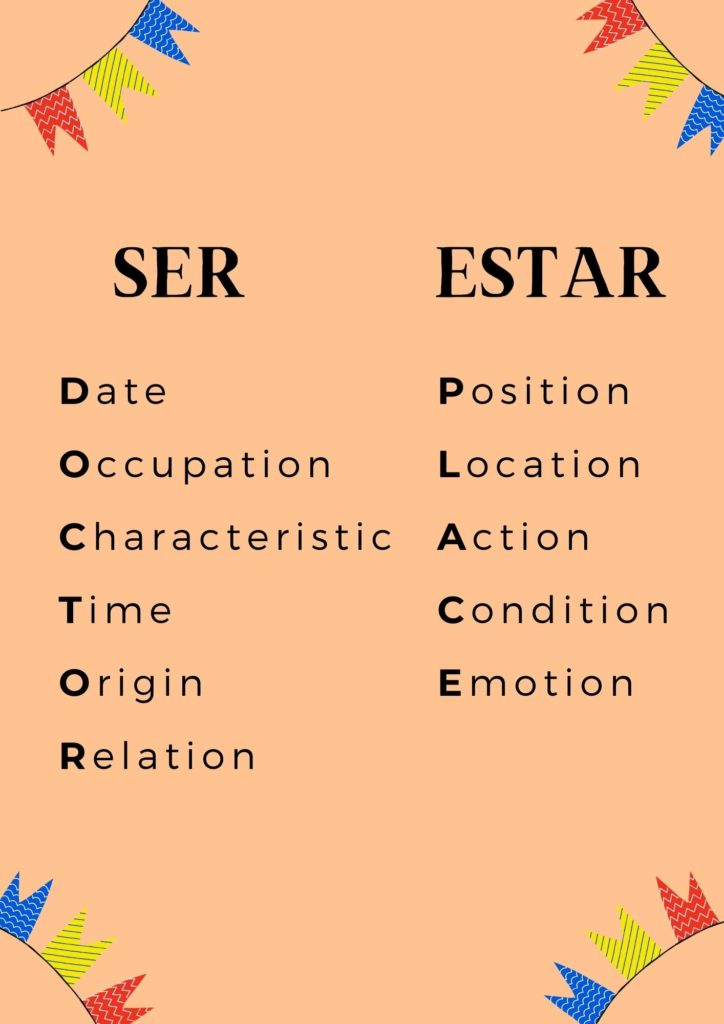The verb ‘to be’ in Spanish can be quite confusing, because it has two variants: ‘ser’ and ‘estar’. Making mistakes using these verbs is quite common, and in this guide we’ll give you easy tips on how to use the correct one.
The verb ‘to be’ in Spanish has two forms, ser and estar. As a general rule, ‘ser‘ is used to describe the date, occupation, physical characteristics, time, place of origin, and relation. ‘Estar‘ is used to describe temporary things, such as your position, location, ongoing actions, physical or mental condition, and emotions.
The main difference between ‘ser’ and ‘estar’ is that the former refers to permanent things that are likely won’t change with time (of course, there are exceptions that we’ll also see). As for ‘estar’ is typically used for temporary situations, as well as for referring to where you are at the moment of speaking.
To clarify, when we say ‘ser y estar’ we’re talking exactly about the verb ‘to be’. There’s no difference or distinction, except the fact that in Spanish ‘to be’ comprises these two verbs.
To start with, let’s take a look at conjugations in both cases and then give some examples. I’ll also add conjugations in South American Spanish:
1. Ser
| Spanish (Spain) | Rioplatense Spanish | English |
|---|---|---|
| Yo soy | Yo soy | I am |
| Tú eres | Vos sos | You are |
| El/Ella es | El/Ella es | He/She is |
| Nosotros somos | Nosotros somos | We are |
| Vosotros sóis | Ustedes son | You are |
| Ellos son | Ellos son | They are |
The verb ‘ser’ is typically used for describing aspect of yourself and others that are unlikely to change with time. Thus, we use ‘ser’ to describe where we come from, our name, and some physical attributes. It’s used the same way when you want to describe others. Let’s see some examples:
- Soy Anna –> I’m Anna
- Soy de Brasil –> I’m from Brazil
- Soy rubia –> I’m blonde
- Although we all know you can change your hair color and that it thus doesn’t fall in a ‘permanent’ category, characteristics such as hair color and body type are described with ‘ser’.
- Soy abogada –> I’m a lawyer
- This one is also tricky. If you have a degree in a certain thing, you use ‘ser’ to refer to it, even though you might work an unrelated job. ‘Ser’ is also used to describe the great majority of jobs, for example “soy taxista” (I’m a taxi driver). Also when you’re a student, even though you might not be one forever, you say “soy estudiante”.
- Soy organizada y tranquila –> I’m quiet and organized
- Even though these traits of your personality might change over time, you also use ‘ser’ to refer to them.
Tip: remember that age in Spanish is described with the verb ‘to have’. Saying ‘soy 25 años’ for saying you’re 25 years old, is a very common mistake. You should rather say ‘tengo 25 años’, which in English it translates as ‘I have 25 years old’.

2. Estar
| Spanish (Spain) | Rioplatense Spanish | English |
|---|---|---|
| Yo estoy | Yo estoy | I am |
| Tú estás | Vos estás | You are |
| El/Ella está | El/Ella está | He/She is |
| Nosotros estamos | Nosotros estamos | We are |
| Vosotros estáis | Ustedes están | You are |
| Ellos están | Ellos están | They are |
‘Estar’ is typically used to describe temporary situations. This is less tricky than ‘ser’, because here you describe the place you are at the moment of speaking, with whom, your mood, etc. Let’s take a look at some examples:
- Estoy en mi casa –> I’m at home
- Estamos con amigos –> We’re with friends
- Estás estudiando? –> Are you studying?
- No estoy muy motivado hoy –> I’m not very motivated today
- Está soleado hoy –> It’s sunny today
As you can see, there’s less confusion on how to use it. If it helps (and as a very general rule), you can think of everything that involves movement (HOW) as ‘estar’, while characteristics that are more static (WHAT) are described with ‘ser’. Of course, as we’ve seen above, that is a very general rule. But if you learn the tricks we’ve talked about in this post, you’ll have no problem distinguishing them.

Mnemonics technique
There’s a mnemonics technique that helps a lot of people when learning ‘ser’ and ‘estar’. I’ve made up this picture for it to help you and will explain it below:

How to use ‘ser’
You can think of the word DOCTOR for ‘ser’ as a mnemonics technique to think about the following words that describe ‘ser’:
- DATE –> Qué dia es hoy? Hoy es miércoles.
What day is it today? It’s Wednesday. - OCCUPATION –> De qué trabajas? Soy profesora.
What’s your job? I’m a teacher. - CHARACTERISTIC –> De qué color es tu sombrero? Mi sombrero es negro.
What color is your hat? My hat is black. - TIME –> Qué hora es? Son las 14.15.
What time is it? It’s 2.15 - ORIGIN –> De dónde eres? Soy de Brazil.
Where are you from? I’m from Brazil. - RELATION –> Quién es ella? Ella es mi hermana.
Who is she? She’s my sister.
How to use ‘estar’
You can also think of the word PLACE for ‘estar’ as a mnemonics technique to think about the following words that describe ‘estar’:
- POSITION –> Dónde estás? Estoy en mi casa.
Where are you? I’m at home. - LOCATION –> Dónde está Juan? Juan está sentado en la silla.
Where is Juan? He’s sitting on the chair. - ACTION –> Nosotros estamos bailando.
We are dancing. - CONDITION –> Estoy enferma.
I am sick. - EMOTION –> Hoy estoy muy contenta.
I’m very happy today.